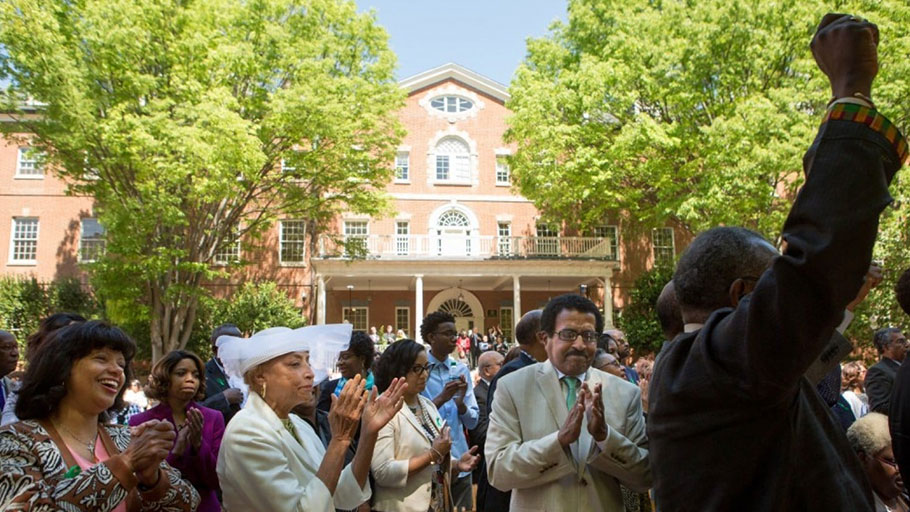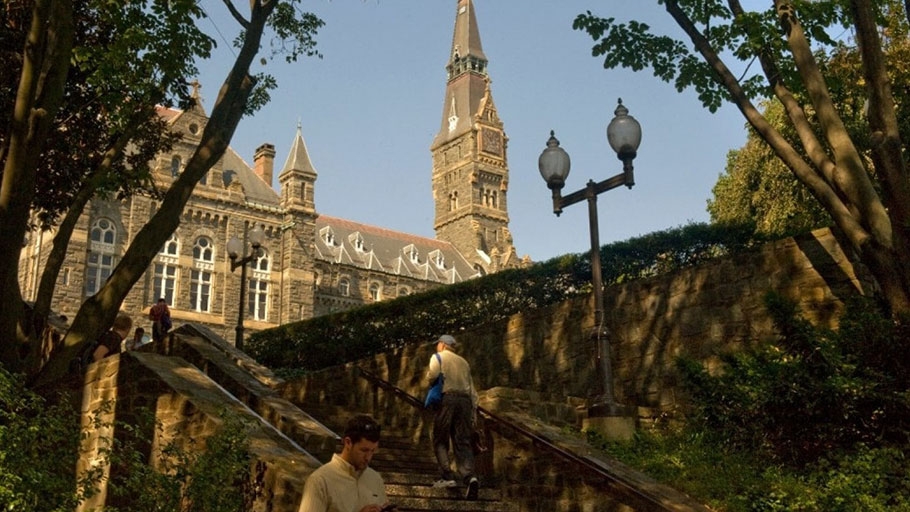Students mill around the campus of Georgetown University. Photo: Nikki Kahn, The Washington Post.
One-hundred-and-eighty years after Jesuit priests sold slaves to save Georgetown University from financial ruin, a group of descendants is calling for restitution.
By Susan Svrluga, Washington Post —
The university’s president has apologized for the sale, and the school has taken steps to make amends. But Georgetown owes its existence to the money made from the sale of 272 enslaved people, argues Georgia Goslee, lead counsel for the GU272 Isaac Hawkins Legacy group. And the school is no longer near insolvency, but instead a thriving, elite university with a substantial endowment.
She declined Wednesday at a news conference to name the amount the group proposed to the university in June but said her clients “do not believe Georgetown has fully atoned for the wealth it unjustly accumulated off the back of unpaid slave labor.”
Asked about the possibility of reparations, a school spokeswoman said Georgetown’s president, John DeGioia, has been clear about the ways the university could most significantly address racial injustice. That includes educational opportunities, perhaps partnerships with historically black universities, or help with college readiness, genealogy, memorials and reunion projects.
Dee Taylor, a descendant of Isaac Hawkins, a 65-year-old slave whose name was first on the bill of sale from 1838, said she appreciates the symbolic gestures the school has taken. “But in my heart, deep down, I don’t feel whole,” she said. “I believe Georgetown has the means to do much more.”
Many universities have been delving into difficult aspects of their histories, including the role of slave labor in building their institutions. At Georgetown, that history is both glaring and meticulously documented: Jesuit priests in Maryland sold 272 slaves in 1838 and used the money to help pay off debts at the struggling school.
As researchers have found descendants of those slaves, the university and the families have grappled with how to reckon with the past, and how best to move forward.
“Since 2015, Georgetown has been working to address its historical relationship to slavery and will continue to do so,” said Meghan Dubyak, a university spokeswoman. “Georgetown has taken initial steps to seek reconciliation, beginning with offering a formal apology to descendants; renaming two buildings, including one for Isaac Hawkins . . . and offering descendants the same consideration in admissions that it gives members of the Georgetown community.”
After many conversations with descendants, Dubyak said, the university and Jesuit leaders reached out to the descendant community “to propose a framework for long-term dialogue, partnership and collaboration. Georgetown and the Jesuits are committed to working with descendants in a process that recognizes the terrible legacy of slavery and promotes racial justice in southern Louisiana, southern Maryland and throughout the nation. We believe that this kind of collaborative, forward-looking approach is the best path toward reconciliation and responding to the challenges of racial injustice today.”
Some descendants are pleased to have so much information about their family history, even its saddest moments. Others are haunted by the sale and the cruel treatment of their ancestors on Louisiana plantations, and have asked the university to do more to make amends. One group of descendants had asked the university to help create a $1 billion foundation for reconciliation.
The GU272 Isaac Hawkins Legacy group, which Goslee said includes 200 people, has asked for a direct benefit for descendants. They will host events throughout the year to mark the anniversary of the sale and the 50th anniversary of the Rev. Martin Luther King Jr.’s death, beginning with a worship service at St. Augustine Catholic Church next week.
Taylor, a 70-year-old from Baton Rouge, described her disbelief when she learned of the sale. She knew the name Isaac Hawkins from her family history, handed down generation to generation. And when she began to learn more about the past, she couldn’t stop thinking about another of the slaves who was sold, just 10 years old when he was sent to Louisiana. “He was on the bottom of the ship. It was wet. It was damp. It was cold.
“I have a 12-year-old grandson,” she said. “When I look at him and I think about that 10-year-old little boy — ” She paused, and dabbed at her eyes, welling up with tears. “I’m a mother. I’m a grandmother. I’m a great-grandmother. I can just see those babies on that ship crying, with their mothers shackled, or left behind. . . . I feel their pain and grief, knowing they would never see each other again.”
Her research led her to cemeteries. “There, I came face-to-face with the reality that these were real people, with real names, with a real history that connected with me and shaped the woman I am today.” She would take an old toothbrush, she said, to clean the headstones to read them. “And then I stood at those graves, falling to my knees with my face on the ground — crying, just crying.”
And she asked herself, she said, “How, in the name of Jesus, could the church I grew up in commit such a hideous sin and bury the truth for so many years?
“How can Georgetown, which owes its existence to these ancestors, claim genuine atonement when descendant families were not at the table when recommendations for making amends were offered, discussed, and chosen?”
Video: In this video, actor Danny Glover calls on Georgetown University to do more for the descendants of 272 slaves sold in 1838 to pay a debt. (Isaac Hawkins Legacy GU272)
Thomas Craemer, an associate professor at the University of Connecticut, helped the group calculate their request for restitution, based on the idea that forced labor created wealth for others than the enslaved people. He said descendants such as Taylor would otherwise have inherited money earned through wages and interest. “The wealth gap between African Americans and white Americans in the United States is rooted in this reality,” he said.
Dubyak said there are thousands of descendants, and that the university official who reached out last week on behalf of the school and Jesuit leaders was hoping to begin to create consensus about next steps.
Video: Georgetown University released a report in 2016 with recommendations on how the university should make amends for the 1838 sale of 272 slaves to pay a debt. (Georgetown University)
Last week, Joseph Ferrara, the vice president and chief of staff of Georgetown University, sent a public message to the descendant families, proposing “with a sense of humility and gratitude,” a draft set of principles for working together.
“We believe seeking engagement and consensus around a set of principles can help us move forward in developing a partnership and determining the most meaningful and significant ideas for our communities to pursue together,” he wrote. “We look forward to your feedback and your ideas. It is our hope that, as you reflect on these principles, you will also share them with additional members of the descendant community.”
Goslee responded: “Dialogue is always a good thing. But we can talk forever while the descendants are languishing, literally dying and in poor health and suffering from the vestiges of slavery . . . If there is real genuine concern, let’s take action.”
Taylor said, “Make it right, plain and simple.”

A crowd marks the renaming of two Georgetown University halls to memorialize Isaac Hawkins and Anne Marie Becraft in 2017. Hawkins was one of 272 enslaved people sold in 1838 by the school, and Becraft was a free woman of color who founded one of the first schools for black girls in Georgetown. (Allison Shelley/For The Washington Post)
Susan Svrluga is a reporter for the Washington Post, covering higher education for the Grade Point blog.















